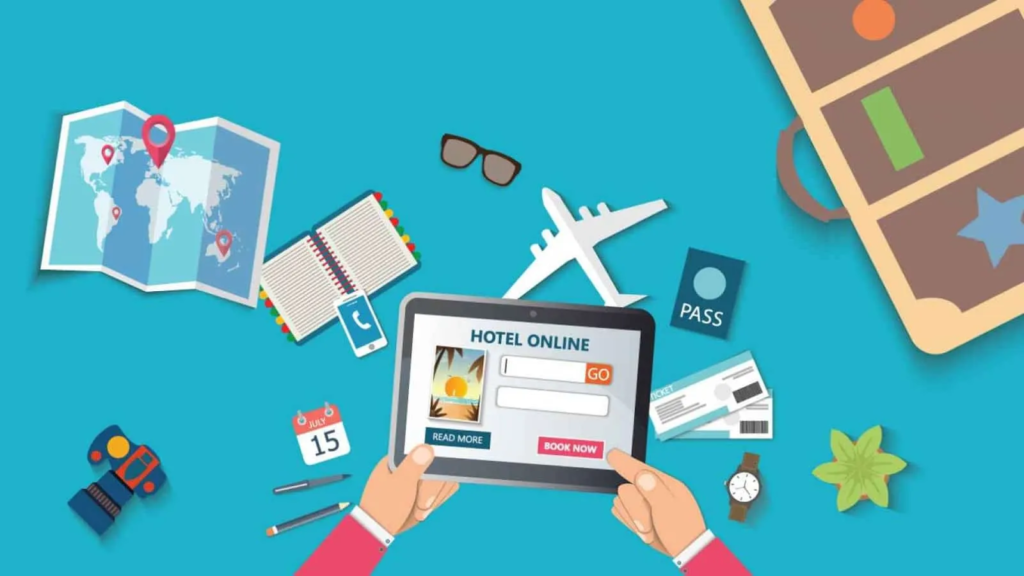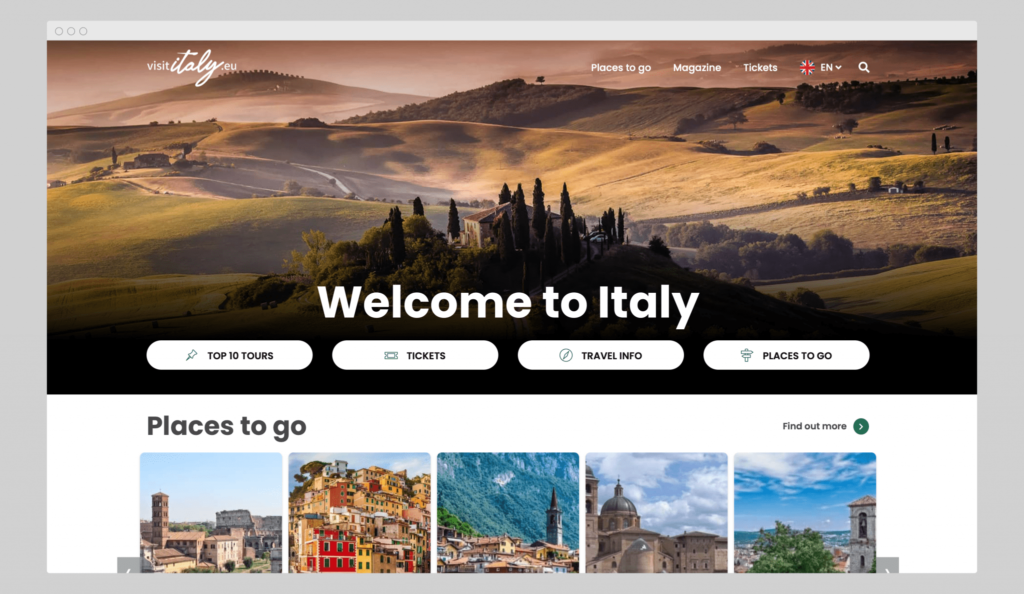The tourism industry is one of the most competitive industries in the world. With so many travel agencies and tour operators vying for attention, it can be difficult to stand out from the crowd. With the evolving digital landscape in 2023, it is crucial for travel businesses to stay ahead of the game by implementing effective go-to-market strategies.
In this blog, we will explore advanced digital marketing strategies for tours and travel, covering everything from the basics to more advanced techniques that are working in 2023
Why digital marketing is essential for the tours and travel industry:

Img Source: Google Images
1. Wide Reach and Increased Visibility:
Digital marketing allows tours and travel businesses to expand their reach beyond geographical boundaries. With the power of the internet, you can showcase your offerings to a global audience.
2. Targeted Marketing and Personalization:
One of the significant advantages of digital marketing is the ability to target specific demographics and interests. Through data analytics and segmentation, you can identify and target your ideal audience with precision.
3. Cost-Effectiveness:
Compared to traditional marketing methods, digital marketing offers a cost-effective solution for tours and travel businesses, This allows you to maximize your return on investment (ROI) by focusing your resources on the most effective channels and strategies.
4. Real-Time Communication and Customer Engagement:
Digital marketing enables instant and direct communication with your audience. Through social media platforms, email marketing, and live chat features on websites, you can engage with potential travelers in real time.
5. Data-Driven Decision-Making:
The data empowers you to make data-driven decisions, optimize your marketing strategies, and allocate resources more efficiently.
Understanding the Tours & Travel Audience

To create a successful digital marketing strategy for your tours and travel business, it is crucial to have a deep understanding of your target audience.
Here are some key steps to understanding your audience:
1. Market Research and Competitor Analysis:
Start by conducting thorough market research to identify trends, demands, and gaps in the tours and travel industry. Study your competitors to understand their target audience and the strategies they are using.
Analyze their strengths and weaknesses to find opportunities for differentiation.
For example, if you notice that your competitors focus on luxury travel experiences, you might consider targeting budget-conscious travelers who are looking for affordable yet quality options. This differentiation can give you a competitive edge and help you attract a specific segment of the market.
2. Creating Buyer Personas:
Once you have gathered market insights, it’s time to create detailed buyer personas. A buyer persona is a fictional representation of your ideal customer, based on research and data.
It helps you understand your audience’s demographics, interests, needs, pain points, and preferred communication channels.
To create accurate buyer personas, consider conducting surveys, interviews, or using data analytics tools to gather information from your existing customers.
For Example: let’s say you operate a travel agency specializing in adventure tours. One of your buyer personas could be “Adventure Enthusiast Emily.”
She is a 30-year-old professional with a passion for outdoor activities and seeks thrilling experiences.
3. Tailoring Marketing Messages and Channels:
Once you have identified your buyer personas, tailor your marketing messages and choose the appropriate communication channels. Speak directly to their needs and aspirations, addressing their pain points and offering solutions.
For example, if one of your buyer personas is a family-oriented traveler seeking child-friendly destinations, you can create content that highlights family-friendly activities and accommodations.
Use emotional appeals and storytelling techniques to connect with your audience on a deeper level.
4. Continuously Monitor and Adapt:
Understanding your audience is an ongoing process. As trends and preferences evolve, it’s essential to continuously monitor and adapt your strategies.
Keep a pulse on industry news, follow social media conversations, and engage with your audience through surveys or feedback mechanisms.
Building a Solid Foundation In the highly competitive world of tours and travel, having a strong digital foundation is crucial for success

A. Developing a Comprehensive Website
Your website serves as the digital storefront for your tours and travel business. It’s important to create a website that is not only visually appealing but also user-friendly and informative. Here are some key aspects to consider:
- User-friendly design and navigation: Ensure that your website is easy to navigate, with clear menus and an intuitive layout. Visitors should be able to find the information they need quickly and effortlessly.
- Mobile optimization and responsive design: With the increasing use of mobile devices, it’s vital to optimize your website for mobile viewing.
A responsive design will ensure that your site adapts to different screen sizes and provides a seamless experience across devices.
- Fast loading speed and optimized performance: Website loading speed is a critical factor for user satisfaction and search engine rankings.
Optimize your site’s performance by compressing images, minimizing scripts, and leveraging caching techniques.
B. Implementing Search Engine Optimization (SEO)
To ensure your tours and travel business is discoverable online, it’s essential to implement effective search engine optimization strategies. Here are some key considerations:
- Keyword research and analysis: Conduct thorough research to identify relevant keywords related to your travel offerings.
Use tools like Google Keyword Planner or SEMrush to find keywords with high search volume and low competition.
- On-page optimization techniques: Optimize your website’s meta tags, headers, and content using your target keywords. Ensure your URLs are descriptive and include relevant keywords.
Focus on providing valuable and informative content to engage both users and search engines.
- Building high-quality backlinks: Backlinks from reputable and relevant websites can significantly boost your website’s authority and visibility.
Engage in outreach campaigns, guest posting, and collaborations with influencers or industry partners to acquire high-quality backlinks.
- Local SEO strategies for location-based targeting: If your tours and travel business caters to specific geographic locations, leverage local SEO strategies. Claim and optimize your Google My Business listing, create location-specific landing pages, and encourage customer reviews to enhance local search visibility.
C. Utilizing Content Marketing
Content marketing plays a vital role in establishing your brand, engaging your audience, and driving organic traffic to your website. Here are some content marketing strategies to consider:
- Creating valuable and engaging content: Develop informative and compelling content that addresses the pain points and interests of your target audience. This could include travel guides, destination highlights, travel tips, and engaging storytelling.
- Blogging and guest posting: Maintain a blog on your website where you regularly publish relevant and valuable articles. Additionally, contribute guest posts to reputable travel websites or collaborate with travel bloggers to reach a wider audience and build backlinks.
- Video marketing and vlogging: Leverage the power of visual content by creating engaging travel videos, vlogs, and destination highlights. Share these videos on platforms like YouTube, Instagram, and TikTok to attract and inspire travelers.
- Leveraging user-generated content: Encourage your customers to share their travel experiences and reviews. User-generated content adds authenticity and credibility to your brand while creating a sense of community among your audience.
Harnessing the Power of Social Media

Social media has become an integral part of our daily lives, and it presents a significant opportunity for businesses in the tours and travel industry to connect with their target audience.
A. Choosing the right social media platforms:
With numerous social media platforms available, it’s important to identify the ones that align with your target audience and business goals.
For example, if you primarily cater to millennials and Gen Z travelers, platforms like Instagram and TikTok might be more effective in reaching and engaging with your audience.
On the other hand, if your target audience includes professionals and corporate travelers, LinkedIn could be a valuable platform for networking and establishing B2B connections.
B. Creating a consistent brand image across social channels:
Consistency is key when it comes to building brand recognition and trust. Maintain a cohesive visual identity, such as using consistent logos, colors, and brand elements, across all your social media profiles.
Additionally, ensure your messaging and tone of voice remain consistent, reflecting your brand’s values and personality. By doing so, you create a memorable and authentic brand image that resonates with your audience.
C. Running targeted ad campaigns:
Social media platforms offer robust targeting options to help you reach your desired audience. Utilize these features to narrow down your audience based on demographics, interests, location, and more.
Example: Let’s say you run a luxury travel agency specializing in high-end vacations. To harness the power of social media, you create an Instagram profile that showcases stunning travel destinations and experiences. You curate a feed with professional-quality photos and videos, highlighting the luxurious aspects of your trips.
D. Social listening and community management:
Engage with your audience by responding to comments, messages, and reviews in a timely and helpful manner. By actively participating in conversations and addressing customer concerns, you can build strong relationships and foster brand loyalty.
Example: Imagine you operate a tour company that offers eco-friendly trips. Through social listening, you notice a growing interest among travelers in sustainable tourism practices. To engage with your audience, you create a Facebook group dedicated to sustainable travel, where travelers can share tips, stories, and recommendations
E. Leveraging user-generated content:
User-generated content (UGC) refers to content created and shared by your customers or followers. Encourage your audience to share their travel experiences, photos, and testimonials using a branded hashtag or by tagging your social media accounts.
Collaborating with influencers in the travel niche can significantly amplify your social media reach and engagement. Identify relevant influencers whose audience aligns with your target market and partner with them for sponsored content, reviews, or destination showcases.
Example: Imagine you run a luxury hotel in a popular tourist destination. You collaborate with a well-known travel influencer who specializes in luxury travel experiences. The influencer stays at your hotel and documents their stay through photos, videos, and Instagram Stories.
G. Utilizing social media contests
Running contests or giveaways on social media can be an effective way to boost engagement, increase your follower count, and create excitement around your brand. Consider hosting contests where participants can win travel vouchers, free trips, or exclusive experiences by following your social media accounts, sharing your content, or tagging friends
Remember, social media is a dynamic and ever-evolving landscape, so it’s important to stay updated with the latest trends, features, and algorithms of the platforms you use.
Use Paid Advertising Strategies:

A. Search Engine Marketing (SEM) with Google Ads
In the highly competitive travel industry, leveraging Google Ads can significantly boost your visibility and attract potential customers. By bidding on relevant keywords, your ads can appear at the top of search engine results pages (SERPs).
For example, targeting keywords like “affordable travel packages” or “best hotels in [destination]” can help you capture the attention of users actively searching for travel-related information.
B. Display Advertising and Remarketing Techniques
Display advertising allows you to showcase visually appealing ads across a wide network of websites and apps. By using eye-catching images and compelling ad copy, you can create brand awareness and entice users to click through. Remarketing takes it a step further by targeting users who have previously engaged with your website or shown interest in your offerings.
For Example, if a user visited your website and viewed a specific tour package, you can show them personalized ads related to that package as they browse other websites.
C. Programmatic Advertising and Real-Time Bidding
Programmatic advertising automates the buying and selling of ad inventory in real-time. It uses advanced algorithms to analyze user data and target relevant audiences at the right moment.
Real-time bidding (RTB) is a crucial aspect of programmatic advertising, enabling advertisers to bid on ad impressions in real-time. This ensures that your ads are shown to the most relevant and valuable users.
For example, if a user has previously searched for flights to a specific destination, programmatic advertising can help you display ads promoting flight deals or vacation packages to that destination across various websites and apps.
D. Social Media Advertising on Platforms like Facebook and Instagram
Social media platforms like Facebook and Instagram offer highly targeted advertising options based on user demographics, interests, and behaviors.
These platforms allow you to create visually appealing ads, videos, and carousels to engage your target audience.
For Example, if your travel agency specializes in adventure travel, you can create an engaging video showcasing thrilling activities like hiking, zip-lining, or scuba diving and target users who have shown an interest in adventure sports or outdoor activities.
Remember, when implementing advanced paid advertising strategies, it’s essential to monitor and optimize your campaigns regularly.
Measuring Success and ROI

A. Defining Key Performance Indicators (KPIs)
Measuring the success of your digital marketing efforts requires establishing clear Key Performance Indicators (KPIs) that align with your business goals.
These KPIs serve as benchmarks for tracking and evaluating the effectiveness of your marketing campaigns. Examples of KPIs for the tours and travel industry could include:
- Website traffic: Monitor the number of unique visitors, page views, and time spent on your website.
- Conversion rate: Track the percentage of website visitors who take a desired action, such as booking a tour, subscribing to a newsletter, or submitting an inquiry.
- Customer acquisition cost (CAC): Calculate the cost of acquiring each new customer, including marketing expenses and resources utilized.
- Return on Advertising Spend (ROAS): Evaluate the revenue generated from your advertising campaigns compared to the amount spent.
B. Tracking and Analyzing Marketing Metrics
To effectively measure success and ROI, it’s essential to track and analyze relevant marketing metrics. This data provides insights into the performance of your campaigns and helps identify areas for improvement. Here are a few examples of marketing metrics to consider:
- Click-through rate (CTR): Measure the percentage of people who click on your ads or email links to gauge their effectiveness.
- Conversion rate optimization (CRO): Analyze the rate at which visitors convert into customers or complete desired actions on your website.
- Cost per lead (CPL): Calculate the average cost incurred to acquire a new lead through marketing efforts.
- Social media engagement: Monitor metrics such as likes, shares, comments, and mentions to evaluate audience engagement.
C. Evaluating the Return on Investment (ROI)
Calculating the ROI of your digital marketing campaigns helps determine their profitability and overall impact on your business.
By comparing the revenue generated against the costs incurred, you can assess the effectiveness of your marketing initiatives. Here’s an example of how to calculate ROI:
ROI = (Revenue – Cost of Marketing) / Cost of Marketing * 100
Let’s say you spent $5,000 on a Facebook advertising campaign, resulting in $15,000 in revenue. The ROI for this campaign would be:
ROI = ($15,000 – $5,000) / $5,000 * 100 = 200%
This means that for every dollar spent on the campaign, you earned an additional $2 in revenue.
Remember, each business may have unique KPIs and metrics based on its specific goals and objectives. It’s important to regularly review and adjust your measurement approach to align with evolving business needs and industry trends.


